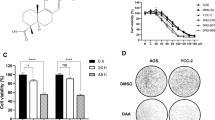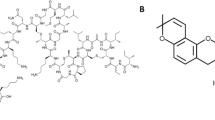Abstract
Purpose
This study was conducted to assay cytotoxic effects of methylsulfonylmethane (MSM) on gastrointestinal cancer cell lines.
Methods
Human gastric carcinoma (AGS), human hepatocellular carcinoma (HepG2), and human esophageal squamous cell carcinoma (KYSE-30) cancer cell lines were treated by MSM and incubated for 24, 48, and 72 h. Cytotoxicity was examined through MTT, neutral red uptake, and protein measurement assays. Ethidium bromide/acridine orange (EB/AO) staining was used for apoptotic cell detection. A diamidino-2-phenylindole staining method was used to analysis cell cycle by flow cytometry.
Results
IC50 of MSM on AGS, HepG2, and KYSE-30 cell lines were 28.04, 21.87 and 27.98 mg/ml after 72 h, respectively. The EB/AO staining showed an increase in apoptotic cells. Cell cycle analysis showed a significant increase in cell density at G2/M phase.
Conclusion
MSM had cytotoxic effect on cancer cell lines but HepG2 cell line was more susceptible. This study suggests that MSM may induce cytotoxic effect on gastrointestinal cancer cell lines by apoptosis and cell cycle arrest.



Similar content being viewed by others
References
Methylsulfonylmethane (MSM). Monograph. Altern. Med. Rev. 2003. 8(4): 438–41.
Christy M. MSM-the super-supplement of the decade. Arizona: Wishland Inc; 1997.
Jacob S, Appleton J. MSM the definitive guide: the nutritional breakthrough for arthritis, allergies and more. Los Angeles: Freedom Press; 2002.
Beilke MA, Collins-Lech C, Sohnle PG. Effects of dimethyl sulfoxide on the oxidative function of human neutrophils. J Lab Clin Med. 1987;110(1):91–6.
McCabe D et al. Polar solvents in the chemoprevention of dimethylbenzanthracene-induced rat mammary cancer. Arch Surg. 1986;121(12):1455–9.
Caron JM et al. Methyl sulfone induces loss of metastatic properties and reemergence of normal phenotypes in a metastatic cloudman S-91 (M3) murine melanoma cell line. PLoS One. 2010;5(8):e11788.
Cox WI, Specter S, Friedman H. Susceptibility of Friend erythroleukemia cells to natural cytotoxicity after in vitro treatment with dimethyl sulfoxide. Proc Soc Exp Biol Med. 1982;169(3):337–42.
Ebisuzaki K. Aspirin and methylsulfonylmethane (MSM): a search for common mechanisms, with implications for cancer prevention. Anticancer Res. 2003;23(1A):453–8.
Satia JA et al. Associations of herbal and specialty supplements with lung and colorectal cancer risk in the VITamins and Lifestyle Study. Cancer Epidemiol Biomarkers Prev. 2009;18(5):1419–28.
Alam SS, Layman DL. Dimethyl sulfoxide as a cholesterol-lowering agent in cultured fibroblasts exposed to low density lipoproteins. Biochim Biophys Acta. 1982;710(3):306–13.
Layman DL. Growth inhibitory effects of dimethyl sulfoxide and dimethyl sulfone on vascular smooth muscle and endothelial cells in vitro. In Vitro Cell Dev Biol. 1987;23(6):422–8.
Morton JI, Siegel BV. Effects of oral dimethyl sulfoxide and dimethyl sulfone on murine autoimmune lymphoproliferative disease. Proc Soc Exp Biol Med. 1986;183(2):227–30.
Barrager E et al. A multicentered, open-label trial on the safety and efficacy of methylsulfonylmethane in the treatment of seasonal allergic rhinitis. J Altern Complement Med. 2002;8(2):167–73.
Magnuson BA et al. Oral developmental toxicity study of methylsulfonylmethane in rats. Food Chem Toxicol. 2007;45(6):977–84.
Horvath K et al. Toxicity of methylsulfonylmethane in rats. Food Chem Toxicol. 2002;40(10):1459–62.
Kelsen D et al. Principles and practice of gastrointestinal oncology. 2008. New York: Lippincott, Williams & Wilkins.
Crew KD, Neugut AI. Epidemiology of gastric cancer. World J Gastroenterol. 2006;12(3):354–62.
Alberts SR, Cervantes A, van de Velde CJ. Gastric cancer: epidemiology, pathology and treatment. Ann Oncol. 2003;14 Suppl 2:ii31–6.
Cabibbo G, Craxi A. Epidemiology, risk factors and surveillance of hepatocellular carcinoma. Eur Rev Med Pharmacol Sci. 2010;14(4):352–5.
Cervantes A et al. The treatment of advanced gastric cancer: current strategies and future perspectives. Ann Oncol. 2008;19 Suppl 5:v103–7.
Ribble D et al. A simple technique for quantifying apoptosis in 96-well plates. BMC Biotechnol. 2005;5:12.
Levesque AA et al. Distinct roles for p53 transactivation and repression in preventing UCN-01-mediated abrogation of DNA damage-induced arrest at S and G2 cell cycle checkpoints. Oncogene. 2005;24(23):3786–96.
Honda I, Watanabe S, Fujita Y. Preoperative adjuvant chemotherapy with oral anticancer agents for stomach cancer. Gan To Kagaku Ryoho. 1997;24(9):1109–17.
Acknowledgments
We are grateful to Mr. Reza Rostami and Ms Negar Molazadeh for helping in the preparation of medium and reagents. This study was supported by a thesis grant for Master of Science in clinical chemistry from Ardabil University of Medical Sciences.
Conflict of interest
We declare that there is no conflict of interest.
Author information
Authors and Affiliations
Corresponding author
Rights and permissions
About this article
Cite this article
Jafari, N., Bohlooli, S., Mohammadi, S. et al. Cytotoxicity of Methylsulfonylmethane on Gastrointestinal (AGS, HepG2, and KEYSE-30) Cancer Cell Lines. J Gastrointest Canc 43, 420–425 (2012). https://doi.org/10.1007/s12029-011-9291-z
Published:
Issue Date:
DOI: https://doi.org/10.1007/s12029-011-9291-z




